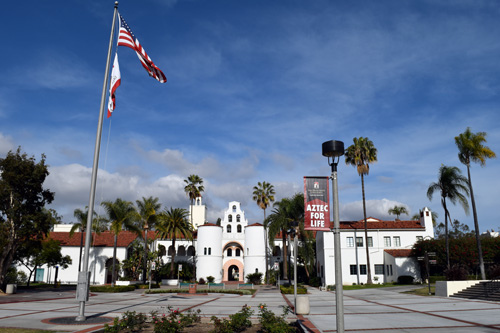
– 28th in a Series –
Exit 10, College Avenue, San Diego ~ San Diego State University
By Donald H. Harrison

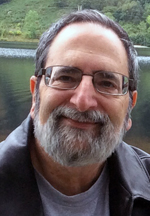
SAN DIEGO — Before I even get started on this chapter, I want to acknowledge a debt to Lawrence “Laurie” Baron, a professor emeritus of history at San Diego State University, who also is my colleague here at San Diego Jewish World. Laurie wrote a paper on the Jewish history of SDSU and has given me permission to borrow from it liberally for this series.
While serving as the longtime director of the Lipinsky Institute for Judaic Studies, Baron was the organizer of the Western Jewish Studies Association, which brings together scholars from throughout the western states. One of the problems facing researchers in American Jewish history and other disciplines has been a tendency to focus on the Jewish communities of the East Coast, treating Jewish communities out west, at best, as an afterthought. Thanks to Baron, Jews from the western states are getting far more academic attention. Since 1995, WJSA meetings have been held in a variety of western cities, including Vancouver, British Columbia, during the organization’s 20th anniversary in 2015.
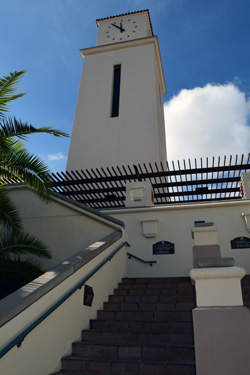
The Lipinsky Institute for Judaic Studies was so named because of an endowment given by Bernard and Dorris Lipinsky whose names also grace the Lipinsky Hospitality Center. Above it rises the Lipinsky Tower, to which students without watches or cellphones refer regularly whenever they want to know the time.
Besides being a philanthropist, Bernard Lipinsky had a long history with San Diego State, so his story is a good place to start our Jewish exploration of SDSU. He attended SDSU in the 1931-32 academic year, and among his favorite history professors was Abraham P. Nasatir, an Orthodox Jew who was so popular with his students and colleagues that since 1986–a dozen years after his retirement–the eastern wing of the former Humanities-Social Science Building has been officially named Nasatir Hall.
Nasatir came to San Diego State in 1928, three years before the college moved from its original home in the Normal Heights area, to what was then known as Montezuma Mesa. With no Orthodox shul close to the new campus, Nasatir “opened his home for a daily minyan for male students who wanted to daven before they went to classes,” according to Baron.
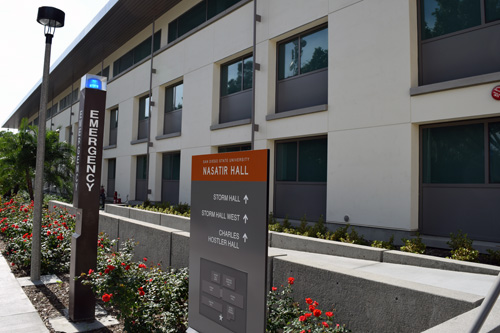
Lipinsky recalled that Nasatir “sometimes asked his students to purchase him a movie ticket for Saturday matinees because he observed the tradition of not carrying money on Shabbat.” Specializing in the history of South America as well as Spanish colonialism in North America, Nasatir authored 18 books. When he died in 1991, he indirectly provided for even more scholarly endeavor. Until the grant ran out, an annual Nasatir Lecture on American Jewish History was a feature of the SDSU calendar.
While Nasatir was apparently well-liked by Jew and Gentile alike, discrimination at the off-campus fraternities and sororities was commonplace at San Diego State and other colleges and universities through the 1960, when it was outlawed. Reportedly, because he was Jewish, sports enthusiast Bob Breitbard (see previous story on Valley View Casino Arena for his biography) was blackballed by one member of a fraternity he had sought to pledge. In the 1930s, such anti-Semitism led to the creation on the rim of the campus of the Aleph Phi Pi fraternity, in which Lipinsky served as chancellor, Bob Breitbard as vice chancellor, and another member was Sol Price, the future founder of the Price Club warehouse stores. Female students in 1933 formed a local chapter of the B’nai B’rith Junior Girls Auxiliary.
The 1940s brought World War II, with many students volunteering to fight. Among local Jewish students who volunteered was Herman Addleson, who first had to have an operation on a cleft lip in order to medically qualify. Unable to afford such an expense, he feared he would have to sit the war out, but Boston Red Sox batting champion Ted Williams–who had grown up in San Diego–came to Addleson’s rescue. He helped pay for the operation that qualified Addleson to apply for the paratroopers. Sadly, Addleson was killed while parachuting behind Nazi lines in France on D-Day, June 6, 1944. His name is listed with other KIA on a monument on the San Diego State campus.
Following the war, with many members of the military coming home with their GI benefits, San Diego State hired many new faculty members, among them three who became active in the Jewish community: Ernest Wolf, Harry Ruja, and Oscar Kaplan. Along with Abraham Nasatir, they successfully campaigned for the establishment of a Hillel chapter on the San Diego State campus. The chapter was inaugurated in a ceremony attended by 650 people at Congregation Beth Israel at which the president of Brandeis University, Abraham Sachar, was the keynote speaker.
In 1948, San Diego State students elected their first student president who was Jewish: Duane Kantor, who had remained neutral in a campus battle over whether fraternities and sororities should be required to abandon their discriminatory practices. Students Larry Solomon and Bob Levy subsequently led the campaign to create Beta Tau as a local Jewish fraternity. In 1951, it became part of the national Zeta Beta Tau (ZBT) Jewish fraternal organization. Two other Jewish fraternities, Alpha Epsilon Pi and Sigma Alpha Mu, were chartered on the SDSU campus, respectively in 1970 and 1983.
Jewish women meanwhile created Alpha Epsilon Phi sorority, with Harry Ruja an advisor. One of its members, Judy Gumbiner, said she pledged the sorority to meet other Jews and to remain Jewishly active. She was also active in campus-wide activities, and was honored three times as Woman of the Year by the Associated Student Council.
In 1962, a campus group advocating free speech invited the neo-Nazi George Lincoln Rockwell to address the campus, and his speech–or perhaps the controversy surrounding it–attracted 2,000 persons. Rockwell denigrated Blacks and Jews, prompting Jewish student Ed Cherry to jump up on the stage to argue with him, and when Rockwell wouldn’t let him speak, Cherry punched the Nazi. Other students pelted Rockwell with eggs and rocks, and also vandalized his car. Cherry and two other students were disciplined.
Even as study programs were being established on campus regarding African Americans, Native Americans, Chicanos and Women, so too did a Jewish Studies minor come into being. The Jewish faculty group Yavne was formed in 1969 and nine of its members agreed to teach courses on Jewish subjects. The Jewish student population at that time was estimated at 1,000.
In the 1969-70 school year, Rabbi Robert Weisfeld, then director of the San Diego Bureau of Jewish Education, taught courses in Hebrew and Judaism on a voluntary basis. The following year Irving Gefter was given a tenure position to teach Hebrew and Jewish Heritage, and the year after that Ida Sheres taught Bible and modern Jewish literature.
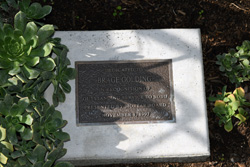
In Brage Golding, San Diego State University had its first Jewish president. He also was the father of San Diego’s first Jewish Mayor, Susan Golding. Brage Golding served SDSU from 1972 to 1977 and reported never encountering anti-Semitism on the campus, not even in late 1973 when the so-called Yom Kippur War pitting Israel against its Arab neighbors broke out, nor two years later when the United Nations passed a resolution equating Zionism with racism–a resolution that it rescinded some years later.
In 1970, the Lubavitcher movement opened a Chabad House near the campus with Rabbi Yonah Fradkin at its head. Under Fradkin’s tutelage, over the next several decades, a network of Chabad Houses were staffed throughout San Diego County. A 1972 SDSU graduate, Lorie Geddis, recalled “traditional Shabbat dinners with lots of kosher wine and stories of the Baal Shem Tov late into the night.” Geddis also attended “Pathways Through the Bible” classes taught by Rabbi Samuel Penner, spiritual leader of nearby Congregation Beth Tefilah, a Conservative congregation.
The United Jewish Federation of San Diego helped Hillel purchase a new building adjacent to the campus, and Rabbi Jay Miller became its director. For a time, Hillel was called the Jewish Campus Center, but it subsequently reverted to the Hillel name.
In the 1980s, the number of Jewish students enrolled at SDSU climbed to an estimated 3,000. Yet, impending budget cuts imperiled most Jewish studies courses. Students and faculty lobbied the University’s Development Office to approach potential donors in the community, and Jewish faculty members issued an appeal for support from the community.
Prof. Jacob Goldberg of Tel Aviv University was retained to speak at a fundraising event to enlarge the formal Jewish Studies program–a proposal that garnered considerable support in the local Jewish community after Nation of Islam firebrand Louis Farrakhan had been scheduled to deliver an anti-Semitic speech on campus. SDSU refused a demand from Farrakhan that his own armed body guards come on campus to protect him, and the speech was cancelled. Meanwhile, at the urging of SDSU’s then-President Thomas Day, Bernard Lipinsky decided at this point to endow a permanent chair in modern Jewish history and to underwrite an annual visiting Israel professor.
Before Baron took over as director of the Lipinsky Institute for Judaic Studies, there was a temporary director chosen from the faculty. He was history professor Bob Filner, who later would serve as a school board member, San Diego city councilman, and a member of Congress before being elected in 2012 as mayor of San Diego. In a plea bargain, Filner resigned as mayor a year later after a scandal erupted in which he was accused of sexually harrassing many women.
Another Jewish development on the campus took place in secret. The Fred J. Hansen Institute for World Peace was created from the estate of a local avocado grower, whose executors asked for proposals for advancing the cause of international peace either in the field of marine biology or agriculture. In the wake of the Camp David agreement of 1979, bringing peace between Israel and Egypt, San Diego State University proposed to administer a program in which agricultural experts from the two former enemy nations could meet quietly, out of the public limelight, to discuss ways to cooperate in ways to grow foods in their deserts. The Jewish director of the Hansen Institute, Robert Ontell, was able to organize such meetings on the campus. Gradually and without publicity other Middle Eastern countries–including some that had no diplomatic relations with Israel–allowed their agricultural experts to participate.
This program led SDSU President Steven Weber to invite Israel’s former prime minister and future president, Shimon Peres, to receive an honorary doctoral degree from the university in 1997, one of only a few that had been granted up to then. The others had been conferred upon U.S. President John F. Kennedy and Bernard Lipinsky. Weber and a delegation from SDSU also attended the inaugural international board meeting of the Peres Center for Peace, and ten years later returned to Israel for the dedication of the Peres Peace House in Jaffa.
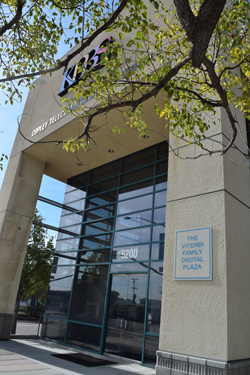
Following Weber’s retirement as SDSU’s president, Elliot Hirshman became the second Jewish president in the university’s history. Previously he had served as provost and senior vice president for academic affairs at the University of Maryland.
During Baron’s tenure, the Jewish Historical Society of San Diego, under the leadership of Stan and Laurel Schwartz, decided to locate its archives at SDSU’s Love Library in collaboration with the Special Collections Department.
Baron, now professor emeritus, was succeeded as director of the Jewish Studies program by Risa Levitt Kohn, who also served as a curator of a Dead Sea Scrolls exhibition at San Diego’s Natural History Museum in Balboa Park.
Today names of some additional Jewish philanthropists grace the SDSU campus. There is a Viterbi Digital Plaza outside the KPBS Building, the plaza having been named for Andrew Viterbi, the co-founder of telecommunications giant Qualcomm. Among well-known personalities on the KPBS television and radio news broadcasts was Gloria Penner, a member of the Jewish community who died in 2012 after nearly a half-century long career with the public broadcasting station.
Other Jewish contributors to the campus are Lee and Frank Goldberg, for whom is named the plaza that serves as a central courtyard for the Aztec Student Union, opened in 2013. Frank Goldberg founded a furniture store in suburban Chula Vista that grew into a chain of 11 stores in California and Nevada.
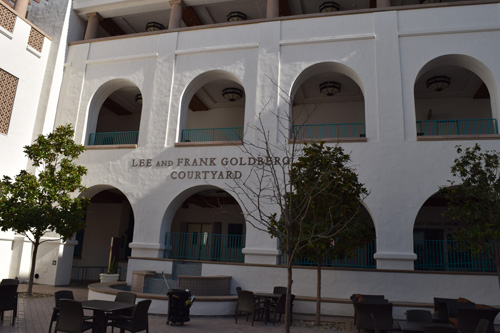
Following in her father Bernard’s philanthropic footsteps, Elaine Lipinsky endowed a program for an Artist in Residence associated with the Jewish Studies Program. Ethnomusicologist Yale Strom, a documentary film maker, composer, and klezmer musician, has taught and performed at SDSU under the auspices of that program since 2006.
Like many campuses across the United States and Canada, SDSU saw an upsurge of pro-Palestinian, anti-Israel activity in 2014 in the form of the Boycott, Divestment and Sanctions movement against Israel. Some Jewish students complained of being intimidated by increasingly vocal and hostile demonstrations against the Israeli government, while others rallied to Israel’s defense, nurtured by such pro-Israel organizations as StandWithUs.
*
Professor Baron’s article “From Minyan to Matriculation: San Diego Jewry and Jewish Studies at San Diego State University,” was published in 2003 as a chapter in California Jews, edited by Marc Dollinger and Ava Kahn, and published by Brandeis University.
Next: SDSU’s Jewish President
*
Harrison is editor of San Diego Jewish World. You may comment directly to him at donald.harrison@sdjewishworld.com, or post your comment on this website provided that the rules below are observed.
*
__________________________________________________________________
Care to comment? We require the following information on any letter for publication: 1) Your full name 2) Your city and state (or country) of residence. Letters lacking such information will be automatically deleted. San Diego Jewish World is intended as a forum for the entire Jewish community, whatever your political leanings. Letters may be posted below provided they are responsive to the article that prompted them, and civil in their tone. Ad hominem attacks against any religion, country, gender, race, sexual orientation, or physical disability will not be considered for publication. There is a limit of one letter per writer on any given day.
__________________________________________________________________
Really enjoyed reading the history of SDSU and seeing names of professors I had in the past, including Abraham Nasatir, who was on my thesis committee. He was a student of Herbert Eugene Bolton who translated the Anza Expedition diaries of the 1700s proving that the expedition route from Sonora, Mexico, to San Gabriel was through Anza-Borrego Desert State Park rather than through the Coachella Valley, as had previously been thought. Nasatir, without my knowledge and with great kindness, gave my draft of the history of Anza-Borrego Desert State Park to Richard Pourade, editor of Copley Books at the Union-Tribune. What a surprise it was to me to have received a contract from Copley Books in the mail to publish my MA thesis! It was only possible because of Nasatir’s intercession. My bound thesis and my book — “Our Historic Desert: the Story of the Anza-Borrego Desert State Park” — came out in 1973. Thanks so much for giving me more background on one of the best professors I ever had at SDSU.
–Diana Lindsay, Co-publisher, Sunbelt Publications, El Cajon